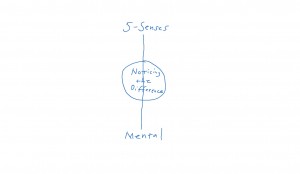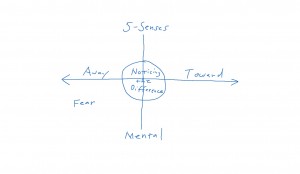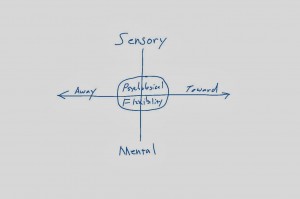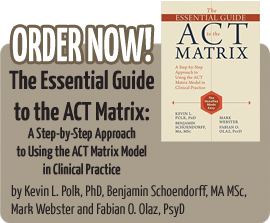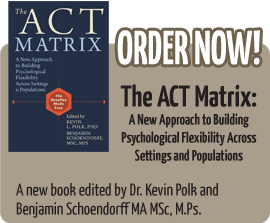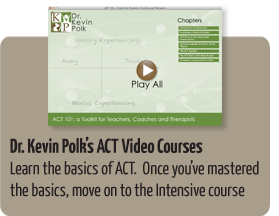I will be presenting to the New England ACBS Chapter on March 3, 2014. You can find them on the ACBS Website (http://contextualscience.org/new_england_chapter). I will be sending materials prior to the presentation. If you would like to receive those materials, sign up for this event at http://events.constantcontact.com/register/event?llr=455lm4iab&oeidk=a07e8r4ju4s06afffcd.
This is work that I do with David Sloan Wilson (evolutionary biologist), Steve Hayes (clinical psychologist) and others toward influencing workgroups of all kinds. As we all know, workgroups can be great. Then again, they can be miserable and stuck. If we can influence the miserable and stuck ones toward being fun and creative, then life just might be better for us all.
The idea is to combine the psychological flexibility model (ACT is built on the psychological flexibility model) with evolution science. The core notions of evolution science are Variability, Consequences and Heritability. From a biological perspective this means that with each new set of offspring there is some variability. Said another way, the children are slightly different than the parents due to DNA and other factors. Some of those variations can lead to consequences. Some are life, death and the ability to produce offspring. The ability to produce offspring with where the heritability comes in. Through DNA the successful variability is inherited by the offspring. As this Variability, Consequences and Heritability process operates across thousands and millions of years, we can see how this process influences the fossil and other evidence.
Humans also know how to influence each other in the short term. This is necessary because humans are social animals who join together to increase the chances of survival of each other and ultimately the human race. ProSocial is concerned with small groups of people who join together for the common good.
Elinor Ostrom observed many groups around the world who came together to manage some common resource like water. She observed those that were succeeding and those that were not doing as well. She finally articulated what she observed as 8 design principles of successful groups. They have since been known as Ostrom’s 8. Teaching Ostrom’s 8 has become a way of influencing groups toward more successfully managing common resources. What if Ostrom’s 8 could be used to help groups working toward some common goal such as having a better neighborhood or workplace? The jury is still out on whether or not Ostrom’s 8 can help such groups, largely because getting groups to the point of using Ostrom’s 8 is a challenge. Once we can get them using Ostrom’s 8, then we can tell if the idea works.
There are of course many ways of looking at how a low functioning group might not learn and use Ostrom’s 8. Contextual-Behavioral Science looks at it from the psychological flexibility point of view. Psychological flexibility (and inflexibility) is part of language. The idea is that language rules (often called verbal rules) can become rigid and inflexible. An example is the following familiar exchange:
Question: This is not working, why are we doing things this way? Answer: Because it’s the way we have always done them.
Of course things could be done differently, but the verbal rules are being treated like the law of gravity. Relational Frame Theory (RFT) is the name of science behind how language gets so much power over human behavior. Since RFT seems to do a pretty good job of explaining how humans get stuck in verbal rules, we can then create a method for reducing the stuckness on verbal rules. One of those is called Acceptance and Commitment Therapy (ACT).
So the idea is to use ACT to loosen the grip of verbal rules on a workgroup and then quickly show them what has been observed as workable and flexible set of rules called Ostrom’s 8. (ACT at Work is already in book form and it has been well researched as a stress management intervention.) However, ACT is a bit large and cumbersome for the task, especially for engaging very low functioning workgroups. A much less cumbersome way of introducing the ACT process and beginning to loosen up a group is The ACT Matrix.
The ACT Matrix boils down the ACT process of loosening the dysfunctional impact of language. First comes the vertical line that represents the process of transforming real world sensory information into mental (verbal) processing. Next comes horizontal line that represents the function (or purpose) of behavior. In just a few minutes a group of individuals can be taught how to Notice each of these processes by noticing the difference between sensory and mental experiencing and noticing the difference between how it feels to move toward (one function of behavior) and how it feels to move away (another function of behavior). Noticing these two differences quickly works to lessen the impact of verbal rules on behavior, which is known as increasing psychological flexibility.
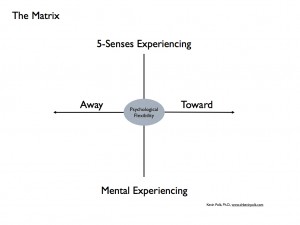
The ACT Matrix
With the increased psychological flexibility in place people are better able to learn Ostrom’s 8 and put them into practice. When using the ACT Matrix diagram this is done by adding two lines to the diagram and relabeling the spokes.
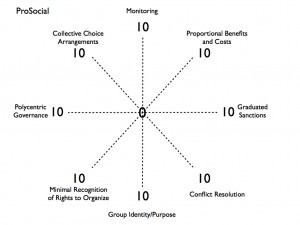
The Spoke Diagram
Notice also that each spoke is numbered from 0 to 10. This is a way that the workgroup can later monitor how they are doing on each of Ostrom’s 8. So if a group measured itself as having all 10s, then the group would be rolling along (spoke and wheel metaphor). A workgroup that had one or more significantly less then 10, e.g., 5, would be having a bumpy ride.
At this point the workgroup learns more about Ostrom’s 8 and how to implement each spoke. Such learning is a process.
Notice that at this point we have increased the Variability of workgroup behaviors by reducing the impact of unworkable verbal rules. The workgroup then observes the Consequences of the new behaviors and keeps the ones that work and discards those that don’t. Finally, the new behaviors are passed along to future workgroups (Heritability through language). It’s the evolutionary process applied to workgroup behaviors.
At this time ProSocial is looking for ProSocial trainers. I will be presenting an overview of that training to the New England ACBS.



